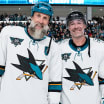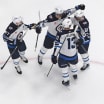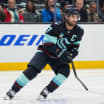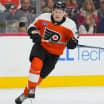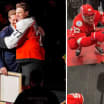Two big trades helped Maple Leafs win multiple Stanley Cup championships
Smythe made moves to acquire Bentley, Schriner in 1940s to build Toronto dynasty
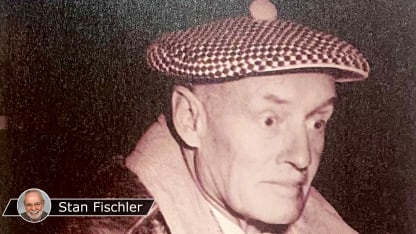
Smythe used that same instinct during his managerial career and often emerged the victor, like in Nov. 1947, when the Maple Leafs traded an entire forward line and two defensemen to the Chicago Black Hawks for all-star center Max Bentley and third-line forward Cy Thomas.
The Maple Leafs traded a lot of talent in that deal, including "The Flying Forts Line" of Gaye Stewart, Gus Bodnar and Bud Poile, one of the top forward units in the NHL. They also included promising young defensemen Bob Goldham and Ernie Dickens.
But Bentley made Toronto the deepest team down the middle, joining Ted Kennedy and Syl Apps. Each of those centers were later inducted into the Hockey Hall of Fame.
Despite all the talent the Black Hawks received, they never made the Stanley Cup Playoffs with those five players. By contrast, Bentley made Smythe look like a genius, helping the Maple Leafs win the Stanley Cup three times (1948, 1949, 1951).
The Bentley trade was inspired by an earlier successful trade orchestrated by Smythe that seemed even was more top heavy for the other team. In that trade made eight years before, the Maple Leafs received only one player, but what a player Dave Schriner turned out to be for them.
Of course, nobody dared call him Dave or David; Shriner despised the name and that's why everybody in hockey new him as 'Sweeney' Schriner. And if you're wondering how that came about, it was kid stuff.
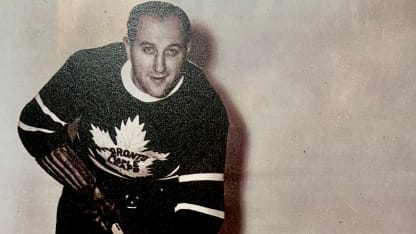
Sweeney Schriner helped the Maple Leafs win the Stanley Cup in 1942 and 1945.
As a young baseball player growing up in Calgary, Schriner idolized a local player named Bill Sweeney, so the locals began calling him "Lil Sweeney," until the "Lil" eventually was dropped.
As for the Schriner trade, it took place May 18, 1939 and involved the Maple Leafs and New York Americans, who acquired five players -- future Hall of Famer Busher Jackson, Doc Romnes, Buzz Boll, Jimmy Fowler and Murray Armstrong.
Schriner scored 18 goals as a rookie in 1934-35 and in his second and third seasons he led the NHL in scoring (45 points in 1935-36; 46 in 1936-37). He had five successful years with New York but was made available when the Americans decided they need to infuse the roster with more depth and talent.
"Schriner was the best left winger I ever saw," Smythe said, "and that included everybody from Bobby Hull to Frank Mahovlich to Busher Jackson. I had my eyes on Sweeney for a couple of years but didn't go for him seriously until 1939."
The press called the 5-for-1 deal unprecedented. But those who knew Smythe best, such as Toronto Daily Star reporter Andy Lytle, knew there was a method to Smythe's seeming madness.
"Smythe made the move deliberately to rid himself of some playing talent that wasn't standing up," wrote Lytle on May 26, 1939. "Boll, Fowler and Jackson were ticketed for disposal weeks before the season ended.
"Romnes was used largely as bait on the hook Smythe cast to secure Schriner. The whole deal smacks of the Smythian determination to mix flaming youth with the steadying influence of experience."
Analyzing the trade, historian-author Andrew Podnieks lauded Schriner as the balance wheel of Toronto's ascent.
"In his four years with the Leafs before World War ll," Podnieks wrote in his book, 'Players,' "he gave the Leafs much-needed scoring.
"Schriner's play proved critical in Toronto's comeback from an 0-3 game deficit against [the Detroit Red Wings] to win four straight games and the Stanley Cup [in 1942]."
Detroit nursed a 1-0 lead through the second period in Game 7 in that 1942 Final. Smythe, who by then was a Major in the Canadian Army, had been given leave to attend the game. At the end of the second, he decided to enter the Toronto dressing room and give a pep talk to his players.
He stopped at Schriner's locker a bit longer than the others. Schriner looked up at Smythe with a grin across his face.
"What ya' worrying about, boss?" he said, "We'll get you a couple of goals."
Schriner scored the tying goal at 6:46 of the third period.
"It was a blind shot," Schriner said. "I didn't know I had scored until I heard the crowd shouting, and then I saw the light go on. It was the biggest light I ever saw in my life."
Seizing the momentum, Pete Langelle put the Maple Leafs ahead at 9:43 and then Sweeney scored again, helping Toronto win the Stanley Cup for the first time since 1932.
There never has been such a comeback in the Stanley Cup Final.
But that wasn't all. In the 1945 Final against the Red Wings, another seven-game series that went the distance, Schriner helped lead the Maple Leafs win another championship.
On the other side of the trade, the Americans reached the Stanley Cup Quarter-finals in 1939 and 1940 and missed the playoffs the next two seasons before folding in 1942.
Conn Smythe helped build a dynasty in Toronto with two seemingly lopsided trades by channeling his gambler persona and coupling it with shrewd hockey IQ.


